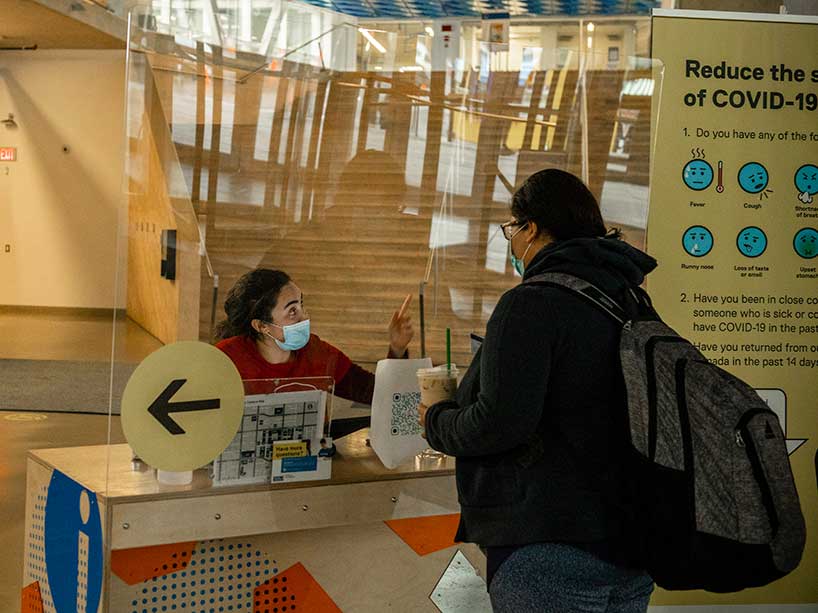Protective measures on campus help keep community safe

At the reception area of the Student Learning Centre, student staff member Niki Nivi guides the students and asks if they have been experiencing any symptoms in the last 14 days before setting them up with spaces booked in advance. Photo: Kiana Hayeri.
How safe is campus during Covid-19? “Our campus is very safe,” says Tanya Vlaskalin. As manager, environmental health and safety, and the university's biosafety officer and Toronto Public Health liaison, Vlaskalin has a holistic view of all the protective measures put in place to adhere to Toronto Public Health (TPH) pandemic protocols.
With remote work and learning, only essential workers, a limited number of researchers, students who live in residence, and students attending a small number of in-person classes are regularly on campus. All buildings are locked, with access restricted to people with authorization to be in a specific building.
Anyone who wants access to the Student Learning Centre and the Library building must pre-book their visit or book at time of arrival if space permits. During the pandemic, there is no access between the Library building and the SLC. This helps manage the number of people onsite and assists with contact tracing and physical distancing.
For onsite Library services, students and other visitors complete a Library-specific informed consent form embedded in the booking request. Once a student arrives, there is additional passive screening at the Library’s second-floor entrance. For more details, see the story about maintaining safe connections in the Library.
Faculty, staff and visitors who have been approved to come to campus by their senior leader have to complete a self health screening form before arriving. The form follows the Ontario Ministry of Health’s COVID-19 screening tool. It requires you to identify if you have any symptoms, if you’ve travelled outside of Canada in the past 14 days, and if you have been in close contact with someone who has tested positive for COVID-19.
Only people who have answered ‘No’ to all the questions pass and can come to campus. Masks or face coverings are mandatory to enter any building on campus, as is physical distancing of two metres or more.
Students are required to complete a health screening self-assessment prior to arrival to campus each day. Students attending on campus for in-person activities are also required to read and complete either an informed consent or a waiver, depending on the scheduled activity.
That’s just the beginning. Ryerson has also implemented robust cleaning protocols that often go above and beyond the twice-daily cleaning and disinfection required by TPH.
Here’s a look at what happens behind the scenes:
Clean spaces
The custodial staff starts the day sanitizing supplies and cleaning their equipment. Disinfectants are hospital grade, Health Canada approved, non-toxic and designed to kill bacteria and viruses.
“Staff are trained on how to best use these disinfectants,” says Garth Poppleton, manager, Custodial & Groundskeeping. “They learn about the optimal dwell time to ensure disinfection agents stay in contact with surfaces for maximum effectiveness.”
Ryerson’s ramped up protocols focus on high-touch surfaces such as doorknobs, card readers and keypads, elevator buttons, light switches, handrails, tables and washroom fixtures.
The deep cleaning continues at night in all high-traffic common areas, which are sprayed with electrostatic disinfectants that cling to surfaces for optimum effectiveness.
Managing exposure and reporting
Ryerson’s reporting process requires anyone who has come to campus and subsequently developed symptoms of COVID-19, tested positive for the virus or learned they’ve been in contact with someone who tested positive to complete a self-declaration form.
“Every single, suspected, probable and actual case is reported and tracked on a database managed by a few individuals,” says Vlaskalin. “Once reported, we monitor and investigate to identify the interactions they had, potential close contacts, the controls in place and what the risks to community members are based on when and where that person was on campus. If anyone is identified to have potentially been exposed to a positive case, we will inform them and advise on next steps following all public health guidelines for individuals who may have been exposed.”
Every positive case linked to an on campus activity is reported to Toronto Public Health. “If TPH deems there’s a risk to anyone at the university, they will communicate back to the university with necessary directives,” says Vlaskalin. “When you put all these controls in place, campus is a very safe space.”
For more information, visit the COVID-19 campus update site.